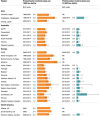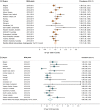Global prevalence of cerebral palsy: A systematic analysis
- PMID: 35952356
- PMCID: PMC9804547
- DOI: 10.1111/dmcn.15346
Global prevalence of cerebral palsy: A systematic analysis
Abstract
Aim: To determine trends and current estimates in regional and global prevalence of cerebral palsy (CP).
Method: A systematic analysis of data from participating CP registers/surveillance systems and population-based prevalence studies (from birth year 1995) was performed. Quality and risk of bias were assessed for both data sources. Analyses were conducted for pre-/perinatal, postnatal, neonatal, and overall CP. For each region, trends were statistically classified as increasing, decreasing, heterogeneous, or no change, and most recent prevalence estimates with 95% confidence intervals (CI) were calculated. Meta-analyses were conducted to determine current birth prevalence estimates (from birth year 2010).
Results: Forty-one regions from 27 countries across five continents were represented. Pre-/perinatal birth prevalence declined significantly across Europe and Australia (11 out of 14 regions), with no change in postneonatal CP. From the limited but increasing data available from regions in low- and middle-income countries (LMICs), birth prevalence for pre-/perinatal CP was as high as 3.4 per 1000 (95% CI 3.0-3.9) live births. Following meta-analyses, birth prevalence for pre-/perinatal CP in regions from high-income countries (HICs) was 1.5 per 1000 (95% CI 1.4-1.6) live births, and 1.6 per 1000 (95% CI 1.5-1.7) live births when postneonatal CP was included.
Interpretation: The birth prevalence estimate of CP in HICs declined to 1.6 per 1000 live births. Data available from LMICs indicated markedly higher birth prevalence.
What this paper adds: • Birth prevalence of pre-/perinatal cerebral palsy (CP) in high-income countries (HICs) is decreasing. • Current overall CP birth prevalence for HICs is 1.6 per 1000 live births. • Trends in low- and middle-income countries (LMICs) cannot currently be measured. • Current birth prevalence in LMICs is markedly higher than in HICs. • Active surveillance of CP helps to assess the impact of medical advancements and social/economic development. • Population-based data on prevalence and trends of CP are critical to inform policy.
© 2022 The Authors. Developmental Medicine & Child Neurology published by John Wiley & Sons Ltd on behalf of Mac Keith Press.
Figures





Comment in
-
Thinking about differences in the worldwide prevalence of cerebral palsy.Dev Med Child Neurol. 2022 Dec;64(12):1436-1437. doi: 10.1111/dmcn.15361. Epub 2022 Jul 28. Dev Med Child Neurol. 2022. PMID: 35899854 Free PMC article.
References
-
- McIntyre S, Morgan C, Walker K, et al. Cerebral palsy‐‐don't delay. Dev Disabil Res Rev 2011; 17: 114–29. - PubMed
-
- Himmelmann K, McIntyre S, Goldsmith S, et al. Epidemiology of Cerebral Palsy. In: Miller F, Bachrach S, Lennon N, O'Neil M editors. Cerebral Palsy. Switzerland: Springer, Cham; 2018.
-
- Oskoui M, Coutinho F, Dykeman J, et al. An update on the prevalence of cerebral palsy: a systematic review and meta‐analysis. Dev Med Child Neurol 2013; 55: 509–19. - PubMed
-
- Galea C, McIntyre S, Smithers‐Sheedy H, et al. Cerebral palsy trends in Australia (1995‐2009): a population‐based observational study. Dev Med Child Neurol 2019; 61: 186–93. - PubMed
-
- Reid SM, Meehan E, McIntyre S, et al. Temporal trends in cerebral palsy by impairment severity and birth gestation. Dev Med Child Neurol 2016; 58 25–35. - PubMed
Publication types
MeSH terms
LinkOut - more resources
Full Text Sources
Medical
Miscellaneous

